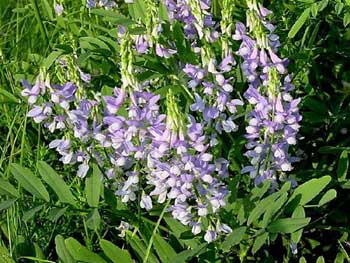Contents:
Common Names | Parts Usually Used | Plant(s) & Culture | Where Found | Medicinal Properties
Legends, Myths and Stories | Uses | Warning | Bibliography
Scientific Names

- Galega officinalis L.
- Pea family
Common Names
- Goat’s Rue
Parts Usually Used
The plant
Back to Top
Description of Plant(s) and Culture
Goat’s rue is a perennial plant; the thick, spreading root system sends up a bushy growth consisting of many hollow, striated stems bearing alternate, odd-pinnate leaves with 6-8 pairs of ovate, entire leaflets which tend to fold together. The lilac to white flowers appear in spikes from June to September. Seeds are borne in long, erect pods.
Another herb goes by the name of goat’s rue (Tephrosia virginiana). It is also of the pea family. It is a silky-hairy perennial, 1-2 feet high, leaves pinnate; 17-29 leaflets. Flowers are bi-colored (yellow base, pink wings); blooms May to August. The seedpod is hairy. May cause contact dermatitis. Contains the insecticide rotenone. Seeds are toxic.
Back to Top
Where Found
Grows wild in southern Europe and western Asia and is cultivated in Europe and the United States.
Back to Top
Medicinal Properties
Diaphoretic, diuretic, galactagogue
Back to Top
Legends, Myths and Stories
An Old World plant.
Back to Top
Uses
Not commonly used today. In the past it was used for fevers, worms and was believed to cure bites from poisonous animals. An extract of the dried plant is sometimes used to stimulate the flow of milk in nursing mothers. The seeds lower blood sugar and stimulates insulin; may be useful for diabetes.
Back to Top
Warning
Sheep have been poisoned by the fresh plant.
Use only under medical supervision.
Back to Top
Bibliography
![]() The Complete Medicinal Herbal
The Complete Medicinal Herbal, by Penelope Ody, Dorling Kindersley, Inc, 232 Madison Avenue, New York, NY 10016, First American Edition, copyright 1993
![]() Eastern/Central Medicinal Plants
Eastern/Central Medicinal Plants, by Steven Foster and James A. Duke., Houghton Mifflin Company, 215 Park Avenue South, New York, NY 10000
![]() The Herb Book
The Herb Book, by John Lust, Bantam Books, 666 Fifth Avenue, New York, NY. copyright 1974.
![]() Webster’s New World Dictionary
Webster’s New World Dictionary, Third College Edition, Victoria Neufeldt, Editor in Chief, New World Dictionaries: A Division of Simon & Schuster, Inc., 15 Columbus Circle, New York, NY 10023
